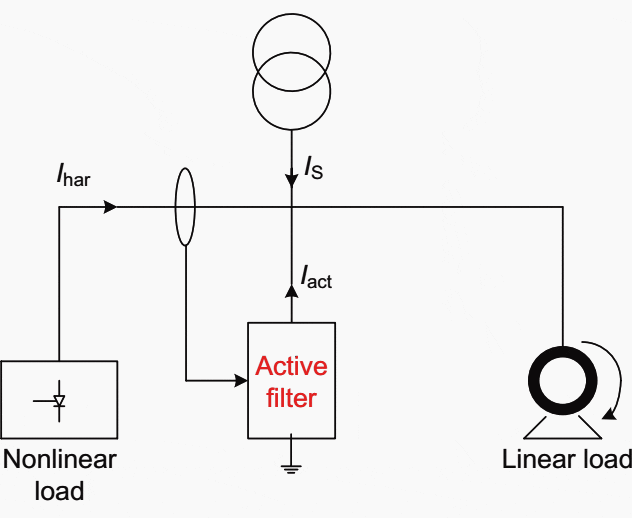Active Harmonic filters are systems employing power electronics. They are installed either in series or in parallel with the nonlinear load to provide the harmonic currents required by nonlinear load and thereby avoid distortion on the power system.
The active filters inject, in opposite direction, the harmonics drawn by the load, such that the line current Is remains sinusoidal.
They are effective and recommended for the commercial installations comprising a set of devices generating harmonics with a total power rating less than 200 kVA (variable – speed drives, uninterruptible power supplies [UPSs], office equipment, etc.).
Also, they are used for the situations where the current distortion must be reduced to avoid overloads.

Where:
Is = source current;
Iact = current injected by active filter;
Ihar = harmonic current generated by nonlinear load.
In general, active harmonic filters(AHF) are special harmonic filters. Active filter is usually utilized in the form of a parallel filter. Note that this part does not analyse the differences between parallel filters and serial filters.
Sometimes, for the term ‘active filter’, the term ‘active harmonic filter’ is more common.
In contrast to the passive filter described above, this filter improves everything right down to the sinusoidal shape of currents or voltages at the connection point.
Active filters supply harmonic currents used by the consumer so that, under ideal conditions, only the fundamental frequency current is still obtained from the distribution network of the local distribution system operator (power utility).
Most active filters are digital (i.e. the harmonic spectrum is determined by amount and phase location from the current measurement and an appropriate counter-phase current spectrum is generated).
Most of the ‘active harmonic filters’ on the market today are current controlled and can filter the harmonic current of a measured load. The harmonic level from the MV or the harmonic generators outside the measuring circuit are not affected by this.
AHF can filter harmonic currents up to their nominal current, whereby an individual so-called derating factor (reduction factor) must be considered for every specific frequency.
Examples of typical applications of the active filter are:
1.Distribution networks in office buildings with a lot of nonlinear loads which cause a total harmonic distortion of THD-I · S/Sr > 20%.
2.Distribution networks whose voltage distortion caused by harmonic currents must be reduced to avoid malfunctions of sensitive loads.
3.Distribution networks whose harmonic current must be reduced to avoid overloads; in particular, those of the neutral conductor.
Some additional typical applications are as follows:
1.Power inverter load with high harmonic feedback and low reactive power requirements.
2.Networks with a high share of the third harmonic due to the use of single-phase consumers.
Some important characteristics of active filters are as follows:
1.Most active filters are current controlled.
2.They can be used without any problems as distributed filters for selected system parts.
3.High power density and thus low space requirements.
4.Reactive power compensation is possible, but this requires expensive resources of the filter.
5.Selective filtering of individual frequencies.
6.Active solutions are much more flexible in their use but also more expensive.
7.Active filters cannot be overloaded regarding harmonic filtering.
Some advantages of active filters are:
1.Reactive power compensation
2.Dynamic compensation
3.Load balancing
4.Flicker compensation
5.Tuned filter circuits
6.Energy savings
7.Voltage stabilization
scan to whatsapp:
